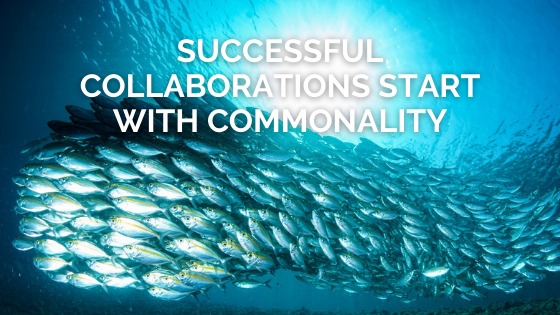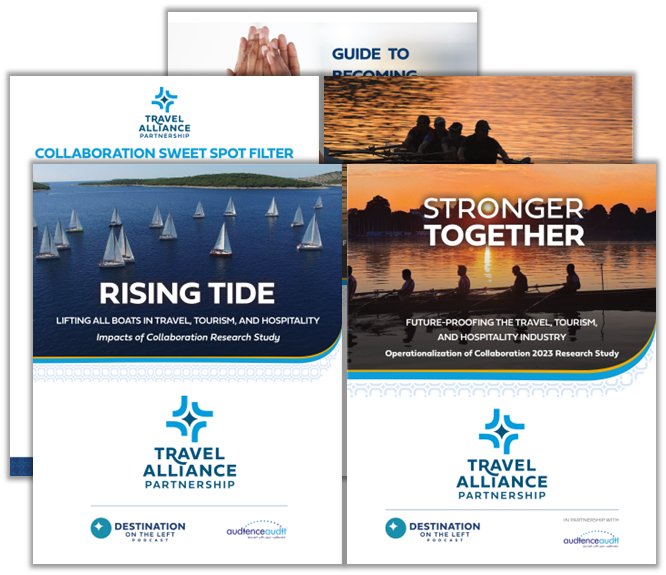Successful Collaborations start with Commonality
In 1987, I worked for my father’s retail electronics store. The business started in the 70’s selling and installing CB radios which eventually led to aftermarket AM/FM/Cassette players and other car audio components. By 1987, our store was one of the only places in Western New York that could install mobile phones in automobiles and business started booming. Suddenly my father’s business went from $1 million to $5 million a year in sales as his clientele changed from gearheads and truckers to professionals and business owners. As a smart entrepreneur and marketer, my father recognized the changing demographics of his customers and began to adapt and make rapid improvements to the overall customer experience.
One of the marketing tactics that helped create loyalty and inspire repeat business was the personal touch of sending thank you and birthday cards to every customer. The cards included generous offers and coupons from my father’s store and other local businesses who served a common demographic audience. My father approached other businesses by offering to include a coupon in every card that he sent to his customers if the other businesses provided a substantial offer on the coupon. Included in the cards were coupons for a free car wash, $10 off a meal at a local restaurant, $25 off a purchase at a local jewelry store among others. During my father’s business boom, we were sending as many as 10,000 cards out per month. This is where the idea of collaborating with others who share something in common started taking shape for me.

Successful hospitality and tourism collaborations start with commonality. The most important commonality elements include:
- Establishing and agreeing on goals for the collaboration
- Having strong champions
- Designing the collaboration to benefit all participants
1. Establishing and agreeing on goals
Prior to seeking collaborative partnerships, you must identify the goals you want to accomplish. I like to follow the SMART goal format––goals should be specific, measurable, attainable, relevant and time-based.
S: Specific
What exactly will you accomplish? In the earlier example from my father’s retail store, the goal was to build loyalty and repeat purchases with existing customers through a thank you and birthday card program.
M: Measurable
How will you know when you have reached this goal? Using the example above, we could measure our customer loyalty through repeat sales. Our collaborative partners could measure the outcomes of the goal through redemption of coupons and new customer acquisition.
A: Attainable
Is achieving this goal realistic with effort and commitment? Have you got the resources to achieve this goal? If not, how will you get them? With the thank you and birthday card program, we had the mailing list, data, budget, and labor needed to prepare and mail them. We needed to go out and get partners to provide value-adds to include in the cards.
R: Relevant
Why is this goal significant to your business, or to society, your industry, or your customers? In our example, the goal is relevant to the customer because it provides them with another connection to the business while introducing them to other local businesses through the generous coupon offers. It is relevant to our collaborators because we share common target audiences and it helps bring them new customers.
T: Time-based
When will you achieve this goal? Finishing up the smart goal for our example, this goal was established as an on-going initiative that occurred monthly.
Once you have established your goals, answer these additional questions:
- Why is this goal important?
- What are the benefits of achieving the goal?
- Which potential obstacles might get in the way of achieving the goal?
- What are possible solutions to the obstacles?
- Who are the people that you will ask to help you achieve the goal?
- What steps need to be taken to achieve the goal?
Being clear on your goals will help you seek out the right partners for your tourism collaboration.
“Setting goals is the first step in turning the invisible into the visible.” – Tony Robbins
As Tony Robbins explains in this quote, knowing what you want to accomplish is the first step in being able to make it visible not only to yourself but to others who will want to join you as well.
2. Strong champions make strong partners
Having strong champions for a collaboration, not only those who are leading it but also those who rally around it and “sell it” to others, is essential to success.
Facing Uncertainty
On the night of March 16th, the last night before the New York State mandated closure of businesses, Heather went out to dinner to get a burger with friends. While at dinner she spoke with the restaurant owner and listened they shared concerns about the uncertainty ahead. It was the day before St. Patrick’s Day and they had a lot of food ready for what was traditionally a big night. There were worries about what to do with the inventory and long-term worries about how to survive a closure. Heather then went next door to a local pub where she found three other restaurant owners talking to each other trying to figure out what to do. One of them, a single mom, was crying because she was worried about providing for her family and the unknown hit her hard.
Listening to these stories, Heather felt the need to do something. After a sleepless night, she got on the phone with her marketing agency, shared the stories and told them she wanted to do something for the restaurants, but she wasn’t sure what to do.
Finding Partners
Over the next 24 hours, Heather and her team reached out to every single restaurant in the county to find out what their plans were and how her office could help. They collected data and kept a detailed spreadsheet of what each restaurant offered for takeout, curbside service, delivery, breakfast, lunch, or dinner. Then the Takeout in Greene campaign was born. Almost overnight, the tourism office developed a website and started a radio and social campaign which launched in March and ran through September 2020.
Out of this came a community and an outlet for the restaurants throughout the county to take a step back and focus on working together to get through the crisis. Many of them got creative. Some started offering dinner packages instead of a one-off meal, a lot of them redid their websites and added online ordering, and others offered delivery service and the ability to have drinks to go. It wasn’t just what the tourism office did that helped them, it’s what the collective effort did to move all of them forward.
A Successful Tourism Collaboration
This turned out to be a perfect case study for a hospitality collaboration. In addition to the restaurants, the tourism office worked closely with the Chamber of Commerce, Economic Development office, and the local radio station to pull this off. There were many champions of the collective goals in this story and they turned out to be strong partners, proving a rising tide truly does lift all boats.
This is a story of coopetition that helped local restaurants survive during the pandemic. COVID-19 pushed the Greene County tourism office to look internally at what they provide for the small towns and local businesses that make up the community.
Commonality can be found when you have common goals, it can also be found when you face a common challenge. Sometimes, it takes a crisis to show us how important working together and collaborating with perceived competitors really is to mutual success.
3. Collaborations benefit all participants
When you find commonality and clearly communicate your goals, tourism collaborations can be designed to benefit everyone involved. A good illustration of how this works can be found on my podcast episode 186, when we learned about the Staten Island shuffle and how a collaboration between competitors lead to more opportunity for everyone involved.
Needing to Attract Visitors
The Staten Island Ferry is a passenger ferry operated by the New York City Department of Transportation. This free ferry ride offers some of the best views of the Manhattan skyline, the Statue of Liberty, and Ellis Island. The ride is very popular among the millions of visitors who go to NYC each year. Sightseers ride the ferry to Staten Island, get off and get back on the next ferry back to Manhattan. Colleen Siuzdak from Visit Staten Island calls this the Staten Island shuffle. The challenge was getting visitors to stay in Staten Island and enjoy the cultural attractions, outdoor experiences, and businesses found there before returning to Manhattan.
Visit Staten Island decided to position the ferry as the front door to the destination, aimed at reframing the ferry from a commuter boat to a fun, free, and exciting sightseeing experience. Beyond that they wanted riders of the ferry to realize it was a doorway, an extension to the Manhattan experience that offered something unique and memorable.
Finding Partners
With this idea in mind, Visit Staten Island reached out to other partners with common interests and created a collaborative branding effort. They engaged with the Staten Island Chamber of Commerce, Empire State Development, and Destination St. George on a collaborative branding project that lead to the creation of a new brand under the “Unexpected Burrough” tagline. The new brand gave the destination a common framework for their positioning and messaging, “if you haven’t seen Staten Island, the unexpected borough, you haven’t actually seen NYC.”
Armed with new brand messaging and the goal of getting more visitors to spend time in Staten Island, Jennifer Sammartino and Colleen Sziudak, leaders with Visit Staten Island, reached across the New York Harbor looking for a partnership that could help them move closer to their goal. They approached the Downtown Alliance in Manhattan, an organization that manages the Downtown-Lower Manhattan Business Improvement District (BID)––the part of Manhattan where the Staten Island Ferry departs. Jennifer and Colleen point out that they were not sure that the Downtown Alliance would be open to working with them because Visit Staten Island was a much smaller destination, Jennifer said they were “small-potatoes” compared to the Manhattan Downtown Alliance.
Collaborating through Commonality
To their surprise, Jennifer and Colleen learned that they shared a common problem with the Downtown Alliance. Both wanted to enhance the visitor experience and serve the visiting public. They found out that roughly 30% of visitors who embark on the Staten Island Ferry wanted to know what there was to do in Staten Island. The visitor services folks for the Downtown Alliance would field these questions daily and had little knowledge about Staten Island, feeling unable to service the visitors.
As a result of this new tourism collaboration, Visit Staten Island invested in digital advertising at the Whitehall Ferry Terminal where the Staten Island Ferry departs, advertising all of the amazing things to do in Staten Island. They also started a brochure exchange with the Downtown Alliance, placing their brochures at Manhattan visitor centers and placing Manhattan brochures at Staten Island visitor centers. Not only did Visit Staten Island solve the problem of the Staten Island Shuffle by getting information into the hands of visitors, but they also enhanced the visitor experience by extending the NYC experience beyond Manhattan and onto the island as well.
Related Posts
Driving Visitation Through Culinary Tourism
When visitors come to a destination, they’re looking for experiences that feel authentic and unforgettable. Few things connect people—or capture the essence of a place—like…
